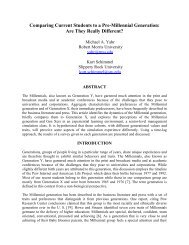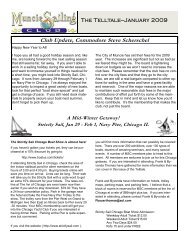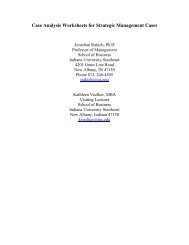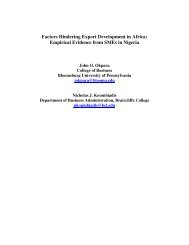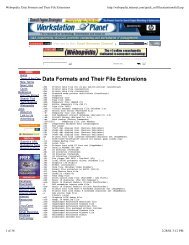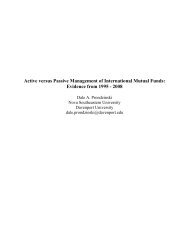Internet-based Applications from the Banking Industry
Internet-based Applications from the Banking Industry
Internet-based Applications from the Banking Industry
You also want an ePaper? Increase the reach of your titles
YUMPU automatically turns print PDFs into web optimized ePapers that Google loves.
{Authors names intentionally omitted} (XXX, XXX, & XXX, 2009) using regression<br />
models find market concentration is not statistically related to measures of bank pricing<br />
including <strong>the</strong> yield on bank assets and <strong>the</strong> bank’s cost of funds. By contrast, <strong>the</strong> study finds that<br />
<strong>Internet</strong> access is statistically correlated to both yields and cost of funds.<br />
Some final observations and caveats<br />
There are numerous o<strong>the</strong>r issues related to this exercise. Instructors may wish to pursue<br />
some of <strong>the</strong>se in order to provide a thorough treatment of market concentration and its<br />
implications. These issues are outlined below.<br />
Technology has blurred traditional geographic markets.<br />
<strong>Banking</strong> markets have been traditionally defined in geographic terms usually anchored<br />
by <strong>the</strong> location of <strong>the</strong> head office of <strong>the</strong> bank. A bank’s market is normally an area that generates<br />
75% of its individual, partnership and corporation deposits (IPC). With <strong>the</strong> rise of on-line<br />
banking, that market definition has been blurred. A consumer can log on <strong>the</strong>ir computer and<br />
quickly peruse sites such as bankrate.com, Ditech.com, LendingTree.com or scores of o<strong>the</strong>r sites<br />
where <strong>the</strong>y can search for and find <strong>the</strong> best available rates on deposits and loans. One<br />
Midwestern bank, for example, at <strong>the</strong> height of <strong>the</strong> housing boom generated about $1.5 billion in<br />
<strong>Internet</strong>-<strong>based</strong> mortgage loans even though <strong>the</strong> bank itself was only $600 million in assets.<br />
The creation of cyber-markets has presented challenges for banking regulators who must<br />
apply laws and regulations that presume geographic market definitions. For example, in<br />
enforcing <strong>the</strong> Community Reinvestment Act (CRA), how does one define <strong>the</strong> market for<br />
evaluating <strong>the</strong> low-to-moderate income segment of <strong>the</strong> population<br />
Changing Regulatory Definitions of Markets<br />
At one time Federal banking regulators focused narrowly on o<strong>the</strong>r bank competitors<br />
when evaluating applications for mergers as well as branching applications. Fur<strong>the</strong>rmore, very<br />
small changes in concentration might be sufficient to deny a merger application for adverse<br />
competitive reasons. At times mergers were sometimes thwarted by <strong>the</strong> doctrine of probable<br />
future competition which argues that removing competition, even if it has no immediate<br />
consequences, might eliminate future competition that would have o<strong>the</strong>rwise existed. Over time,<br />
regulators have recognized <strong>the</strong> importance of non-bank competition, including thrifts, credit<br />
unions, credit card companies, captive finance subsidiaries of auto companies and a variety of<br />
o<strong>the</strong>r financial firms. Today, with favorable legislative accommodation, this competition has<br />
extended to include investment firms, insurance companies, and mortgage companies and o<strong>the</strong>rs.<br />
This has reduced but not totally eliminated anti-competitive concerns.



